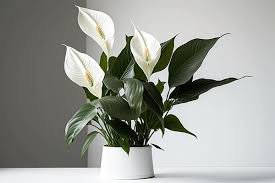Why Peace Lily Is Loved Worldwide?
Peace Lily (botanical name: Spathiphyllum) is one of the most admired indoor plants around the world. It’s beautiful, low-maintenance, and contributes to better indoor air quality. Its elegant white spathes (flower-like structures) and lush green leaves bring life and freshness to any indoor setting.
What Makes Peace Lily Attractive
-
Elegant White Spathes: These look like flowers and bloom throughout the year.
-
Glossy Green Leaves: Rich, dark foliage adds depth and contrast to your room.
-
Compact Size: Fits perfectly in corners, shelves, or desktops.
-
Air Purifier: Proven by NASA to clean indoor air by absorbing harmful toxins.
Special Capabilities
Peace Lily offers more than just beauty:
-
Air Purification: Filters formaldehyde, benzene, and trichloroethylene.
-
Low Maintenance: Grows well even in low light with minimal care.
-
Boosts Wellness: Its presence can reduce stress, improve focus, and create a calming space.
Reference: NASA Clean Air Study, 1989 | University of Florida IFAS Extension, 2023
Creative Ways to Display Peace Lily
-
Use Decorative Pots: Ceramic or glass containers enhance its elegance.
-
Place in Filtered Light: Corners near windows or well-lit shelves are ideal.
-
Groupings: Combine different Peace Lily varieties for a fuller, tropical look.
-
Vertical Display: Use tiered plant stands to show off height and texture.
Repotting, Best Time:
-
Seasons: Spring and early summer are ideal.
-
Time of Day: Morning or late afternoon is best to avoid plant stress.
Tools You’ll Need for Repotting
-
Pot with drainage holes
-
Lightweight potting soil
-
Watering can or spray bottle
-
Gloves, trowel, pruning scissors
-
Newspaper or plastic sheet (for clean workspace)
-
Saucer or tray
-
Optional: stake/trellis for support.
Choosing the Right Pot
-
Material: Ceramic, terracotta, plastic, or metal
-
Size: Just slightly larger than the root ball
-
Drainage: Essential to prevent root rot
-
Style: Match your interior design, but keep functionality in mind.
Indoor Environment Requirements
Factor Recommendation
Light Low to medium, indirect light
Water Water when the top inch of soil feels dry
Humidity 50–60% ideal; mist or use a humidity tray
Air Quality Fresh air flow, avoid pollutants
Temperature 65–80°F (18–27°C), avoid cold drafts
Pest Control for Peace Lily
Pest Signs Control
Aphids Sticky residue, curled leaves Insecticidal soap, neem oil
Mealybugs Cotton-like masses Alcohol-dipped cotton swab
Spider Mites Webbing, speckled leaves Water spray, increase humidity
Scale Insects Hard bumps Soft cloth removal, horticultural oil
Fungus Gnats Flies near soil Let soil dry, use Bt or sticky traps
Prevention Tips:
-
Inspect new plants
-
Isolate infested ones
-
Clean leaves regularly
-
Maintain healthy watering and airflow
Common Diseases and Remedies
Disease Signs Cause Remedy
Root Rot Yellowing, wilting, foul smell Overwatering Remove rot, repot with fresh soil
Leaf Spot Brown/black spots Fungal or bacterial Remove leaves, improve airflow
Yellowing Leaves Pale, slow growth Nutrient deficiency Adjust water, fertilize lightly
Brown Leaf Tips Dry, crispy tips Low humidity or tap water salts Use distilled water, mist leaves
Powdery Mildew White powder on leaves High humidity, poor airflow Remove infected parts, apply fungicide
Gray Mold Soft spots with fuzzy mold Poor ventilation Remove parts, reduce humidity
Fertilizer Guidelines
-
Type: Balanced (10-10-10 or 20-20-20), water-soluble
-
Dilution: Half-strength to avoid root burn
-
Frequency: Every 4–6 weeks in spring/summer
-
Organic Options: Compost tea, fish emulsion, seaweed extract
-
Avoid Over-Fertilizing: Watch for salt build-up or leaf browning
Propagation: How to Multiply Your Peace Lily
-
Best Time: Spring or early summer
-
Method: Division (not cuttings)
-
Steps:
-
Remove plant from pot
-
Separate healthy clumps with roots
-
Pot each in fresh soil
-
Water and keep in indirect light
-
Avoid fertilizing for 4 weeks
-
Pruning and Maintenance
-
Tools: Clean pruning shears or scissors
-
What to Trim: Yellow, brown, or damaged leaves; spent flowers
-
How Often: As needed—best during growing season
-
Extra Tip: Clean leaves with a damp cloth regularly for healthy photosynthesis
Essential Ongoing Care
Care Area Action
Watering Keep soil evenly moist, not soggy
Lighting Bright, indirect is best
Humidity Mist regularly or use a tray
Feeding Monthly during growing season
Cleaning Wipe leaves, remove dead matter
Repotting Every 1–2 years or when root-bound
Monitoring Check for pests or stress signs weekly
Final Thought: A Plant That Gives Back
Peace Lily is more than a houseplant—it’s a natural air purifier, a visual delight, and a wellness booster. With very little care, it rewards you with constant greenery and graceful blooms all year long.
Whether you’re looking to improve your indoor air, create a calm space, or simply enjoy a beautiful, low-maintenance plant, Peace Lily is the perfect choice.
Grow peace, one leaf at a time—with Peace Lily.

